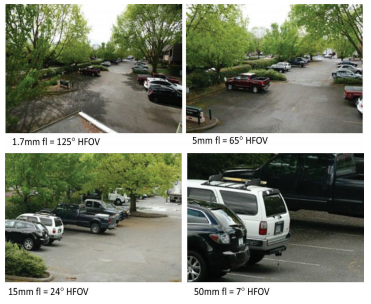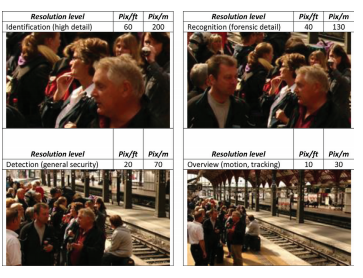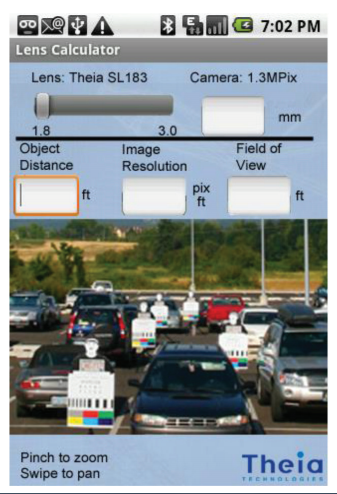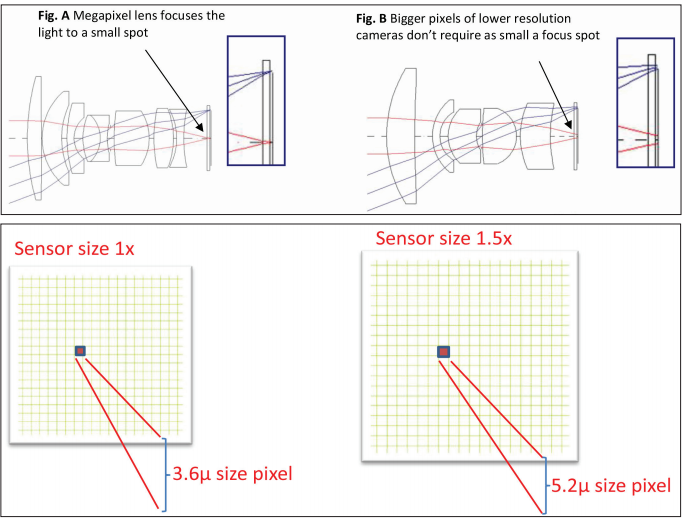Image resolution versus field of view
One important, but often neglected consideration in video surveillance systems design is the trade-off between image resolution and field of view. With any given combination of camera and lens the native resolution from the camera is spread over the entire field of view of the lens, determining pixel density and image resolution. The wider the resolution is spread, the lower the pixel density, the lower the image resolution or image detail. The images below, taken with the same camera from the same distance away, illustrate this trade-off. The widest field of view allows you to cover the widest area but does not allow you to see high detail, while the narrowest field of view permits capture of high detail at the expense of wide area coverage.
camera is spread over the entire field of view of the lens, determining pixel density and image resolution. The wider the resolution is spread, the lower the pixel density, the lower the image resolution or image detail. The images below, taken with the same camera from the same distance away, illustrate this trade-off. The widest field of view allows you to cover the widest area but does not allow you to see high detail, while the narrowest field of view permits capture of high detail at the expense of wide area coverage.
The next series of images, each taken with the same high resolution camera from the same distance away similarly illustrates the trade-off of high detail and ability to identify a person when using a wide angle of view lens and the ability to cover a wide area.
Other ways to improve image detail
So now you see the trade-off. You would like to cover the whole area, but unfortunately you are not able to read the license plate. What to do? At this point, there are a few other variables that you may be able to change in your system design to improve image detail.
First is the distance from the camera to the subject. If possible, the installer could improve the image detail by moving the camera closer to the subject. This may be feasible in a new installation, but in an existing system this may be limited by the physical constraints of the location and the system, as well as costs associated with re-cabling. Moving closer improves the image detail, but field of view is reduced.
The second variable that may be changed is the camera resolution. By selecting a higher resolution camera with a higher starting number of pixels and spreading them over the same field of view as before, the pixel density will be higher and the resulting image detail will be better. Of course, this assumes you can make that change in your system and you can support the likely higher priced hardware and data storage needs required with higher resolution systems. The higher resolution, data intensive cameras will also lower the frame rate of the system which must also be kept in mind especially with industry specific standards and requirements.
Use available tools
There are many useful tools available to help support systems design and correct equipment selection. One of those is Theia’s own image resolution and lens calculator. The calculator allows you to input some important details of your application and potential equipment, then quickly calculates image resolution with those assumptions. You  input the camera resolution and sensor size you intend to use, the lens field of view you believe you need, then input your key project variables – either how much resolution you think you need in terms of pixel density, how much coverage you need in distance (feet or meters), or how far away the camera is from the subject. The tool then calculates the other variables for you.
input the camera resolution and sensor size you intend to use, the lens field of view you believe you need, then input your key project variables – either how much resolution you think you need in terms of pixel density, how much coverage you need in distance (feet or meters), or how far away the camera is from the subject. The tool then calculates the other variables for you.
For example, you indicate you plan to use a 5 megapixel 1/2.5” sensor camera, a 3mm lens and you will be 50 feet away from your subject. The tool will calculate your pixel density – in this case 27 pixels/ foot, and coverage width – here 97 feet wide. The tool then provides an image that represents the level of image resolution you would get for your selected variables allowing you to quickly see if you have enough resolution to meet the needs of your application.
The newest iPhone and iPad versions of Theia’s calculator App include enhancements that allow users to input the camera height and/ or camera angle so that one can tell if a person’s head, for example, will be covered in the image given different distances from the camera. The latest version also allows the user to introduce a level of jpeg noise so that the resulting image more accurately reflects real world conditions.
The importance of lens selection
If you decide to increase your image resolution by increasing the camera resolution, you must also consider lens selection. The lens needed for an IP/ megapixel camera is much different than the lens needed for a traditional analog camera. These higher resolution cameras demand higher performance lenses in order to take full advantage of the increased resolution.
For instance, in a megapixel camera, the focal plane spot size of the lens must be comparable or smaller than the pixel size on the sensor (Figures A and B below), otherwise the light falls off the pixel resulting in a fuzzy image. Using a standard resolution lens with a 5 megapixel camera will produce a blurry image. Most often if you want to take advantage of all the pixels a multi megapixel camera provides, a high quality lens with matching resolution is needed otherwise the money spent on a high resolution camera is wasted.
Using a standard resolution lens with a 5 megapixel camera will produce a blurry image. Most often if you want to take advantage of all the pixels a multi megapixel camera provides, a high quality lens with matching resolution is needed otherwise the money spent on a high resolution camera is wasted.
One would assume, then, that all someone specifying a megapixel camera needs to do is specify a megapixel lens. However, it’s not that simple and in many cases it can be quite difficult to ensure that the lens needed is the lens being offered. Traditionally, just about any decent lens would do the job for traditional analog cameras so specifying the lens wasn’t a problem. As a result, too many designers and integrators are still unaware that for megapixel cameras not all lenses are created equally.
In megapixel cameras the pixel size and the required lens spot size varies depending on the size of sensor and quantity of pixels it contains. You can have 2 different cameras, both 1.3 megapixel, but if the sensor size is not the same the pixel size will be different. The figures below illustrate this.
In selecting a lens it is important to choose one that is designed for use with both the sensor size and the resolution of the camera. Over-specifying the lens to have a higher megapixel rating than the camera is acceptable. This ensures the lens is not the resolution limiting factor in the system.
With a megapixel camera, designers and integrators have entered a new world in which millions of pixels and 1500 pixel wide images are the norm, not the 320 TV lines used in most analog cameras. The old TV lines can now be thought of as rows of pixels. Resolution needs have skyrocketed.
Many manufacturers refer to their products as a ‘megapixel lens’ but they seldom define what the adjective ‘megapixel’ means. Is that ‘MP’ lens to be used with a 1.3 megapixel camera or a 3 megapixel camera? Can it be used with all megapixel cameras?
By referring back to Figures A and B, you would probably expect that different levels of megapixel cameras would also need different lenses. Higher megapixel cameras with their smaller pixels need lenses with more internal glass elements and higher precision elements than lower megapixel models. These superior lenses should deliver the greater performance required for higher megapixel cameras.
What can you do?
So what can help you determine the quality of lens you need? A Line Pair per Millimeter (LP/MM) specification provides the resolution properties of a lens and can be used to help select the correct lens for your camera. LP/MM determines the smallest width of a pair of adjacent pixels that can be resolved by the lens.
Standard analog cameras need a lens with around 30 LP/ MM while megapixel lenses start at 60 LP/MM and can go up to over 200 LP/MM. For example, a lens with resolution of 60 LP/MM on a 1/3-inch 1.3MP camera that has resolution of 133 LP/MM does not utilize the full resolution of the camera. That’s because the lens resolves only 60 LP/MM while the camera requires 133 LP/MM for its full megapixel resolution. The lens cannot focus to see fine enough detail for the camera’s sensor.
In the example above, a feature such as a pole which would be 1 pixel wide will be washed out by the lower lens resolution and not be visible. The pole would have to cover almost 3 pixels before the lens can resolve it. In other words, no object less than 3 pixels wide will be clearly visible with the lens and camera in the example. The consequence is that the extra pixels of the camera are wasted – you paid too much for the camera.
Beware, too, many lenses are labeled megapixel based on the LP/MM in the center of the lens, not at the edge. This difference can be major for you as the user. It’s not uncommon for a megapixel lens to have a 150 LP/MM in the center but only a 60 LP/MM at the edge. This means that the resolution at the edge of the ‘so called’ megapixel lens is no better than that of a standard analog camera lens at half the price.
Also, the size of pixels varies from megapixel camera to megapixel camera, influencing which lens is best for a specific camera. A LP/MM ‘required’ resolution can also be calculated for the camera based on the camera pixel size.
Adding to the complexity, the physical width of pixels in cameras will vary due to their differing image sensor sizes and the number of pixels that must fit on the imager. In other words, you can have two different size sensors each with the same number of total pixels, yet the resolution required of the lens will be different. This means that the LP/MM is relative only to the size of the pixels on the sensor. A lens with a 120 LP/MM might be perfect for a 1.3 megapixel camera using a 1/2 inch imager but not very good for a 2 megapixel camera using a 1/3 inch imager because the pixel size of the latter is much smaller. Ideally the lens resolution should be greater than the camera resolution.
To calculate the LP/MM needed for a given camera, divide the width or height of the sensor in pixels by the physical width or height of the sensor in millimeters, then divide this number by 2. Dividing by 2 is necessary because LP/MM is defined for 2 adjacent pixels (a line pair).
Pixels per chip width / width / 2 = LP/MM
While the LP/MM lens rating was not generally provided by lens manufacturers in the past, it is becoming more common with the adoption of megapixel technology and can be useful in specifying a lens today. However many manufacturers will use a simplified lens rating for the megapixel specification (e.g. 1.3 or 3 MP) and standard sensor size (e.g.1/2 or 1/3 inch).
Get the maximum out of your megapixel cameras
When buying analog cameras, you were concerned about darkness, glare, rain and other factors but seldom gave the lens a second thought. With today’s highresolution, megapixel cameras the lens might be the most important accessory to specify with each megapixel camera. After all, if the lens doesn’t provide the resolution that the camera is capable of producing, you’ve simply wasted your investment on a higher resolution camera.
 “I want a lens that can cover the whole parking lot and I want to be able to read a license plate.” Sounds familiar? As a manufacturer of wide angle lenses, Theia Technologies is frequently asked if we have a product that allows the user to do both of these things simultaneously. And the answer is ‘it depends.’ It depends on several variables – the resolution you start with from the camera, how far away the subject is from the lens, and the field of view of the lens. But keeping the first two variables constant, the impact of the lens field of view becomes clear. One of the important factors to consider when designing video surveillance installations is the trade-off between lens field of view and image resolution
“I want a lens that can cover the whole parking lot and I want to be able to read a license plate.” Sounds familiar? As a manufacturer of wide angle lenses, Theia Technologies is frequently asked if we have a product that allows the user to do both of these things simultaneously. And the answer is ‘it depends.’ It depends on several variables – the resolution you start with from the camera, how far away the subject is from the lens, and the field of view of the lens. But keeping the first two variables constant, the impact of the lens field of view becomes clear. One of the important factors to consider when designing video surveillance installations is the trade-off between lens field of view and image resolution
By Andrea Iniguez – VP Business Development, Theia Technologies